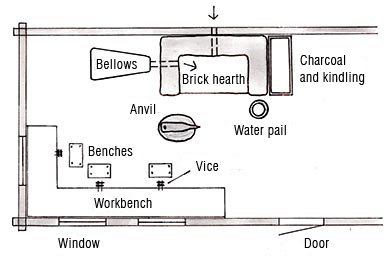In Sweden a distinction was made between blacksmiths (who made horse shoes, tools and nails), gunsmiths, and armor makers on the one hand, and makers of fine ironwork, who made locks, keys, fittings, latticework, and other more ornamental items. For the sake of simplicity, they are called locksmiths here. From the 15th century on, locksmiths gained a privileged status in society. They had advanced technical skills and were master craftsmen in decoration techniques. Their main clients were town burghers, the clergy, nobility who built castles and other large residences, and the Royal Family.
Workplace
Many old wood and copperplate engravings depict the workshops of locksmiths in the 16th and 17th centuries. The simple details in these engravings are practically identical to the workshops of most of Sweden’s locksmiths at that time. The workshop consisted of a room measuring about 20–30 square meters, with relatively small windows in two directions, and a dirt floor. The fixtures consisted of one or two workbenches at table height, placed in front of the windows, and some benches or stools to sit on.
A forge and chimney stood in one corner. The flow of air to the forge came from a pair of bellows made of wood and leather and placed on one side of the chimney. The heavy, German-style anvil stood in front of the forge. It was secured in a thick oak stump that was embedded in the floor. A smaller horn anvil stood close by for making soft curves in the material. The workshops sometimes had a small bench anvil for finishing work on lock components.
The forge was heated with charcoal, which was stored along with kindling in a basket near the anvil. A pail of water stood nearby to quench (cool and harden) the forged metal.
Apart from the light created by the hearth and windows, smoking oil lamps made of clay or metal were used in winter. Train oil, tallow, rapeseed oil, or similar oils were used as fuel, and the wicks were made of textile fibers. Simple brush-wood brooms were used to sweep the floors clean.
 |
| The locksmith's workshop during the 16th and 17th centuries, Illustration by the author. |
Tools
The most important tool was the sledgehammer. It took two hands to use, so an assistant was needed to hold the metal being shaped. Hammers were used after the initial sledgehammer work, and chisels were usually used to cut the iron. Other tools included a hacksaw, a hollow punch or gouge to make holes, and files and burnishers used at the vice or hand vice. Files were also important tools for a locksmith. Their cross section was either square, triangular, or tapered and they were used for work at the bench after the object had been shaped on the anvil. Smiths usually made their tools themselves.
The filed and polished iron objects were often surface-treated to help prevent corrosion. The simplest methods used were annealing, blackening, and coating with oil. More lavish locks were sometimes tinplated, copper-plated or gold-plated. Other decoration techniques included incrustation (applying patterns in another material), applying gold inlay using the hammer, etching or engraving, and punching decorations into the material.